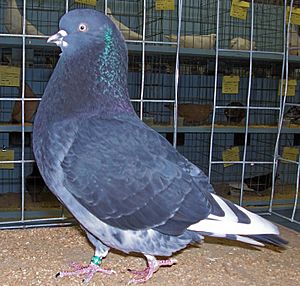Birmingham Roller facts for kids

Birmingham Roller
|
|
| Conservation status | Common |
|---|---|
| Traits | |
| Crest type | None |
| Classification | |
| US Breed Group | Flying |
| Notes | |
| Originally a strictly flying breed it is now cultivated both for show and aerial performance. | |
|
|
The Birmingham Roller is a very popular type of pigeon. It comes from Birmingham, England. People developed this breed to do amazing backward somersaults while flying. This special skill is why they are called "Rollers."
These pigeons were created through selective breeding. This means people carefully chose pigeons with the best rolling skills to have babies. Over time, this made the Birmingham Roller a master of aerial acrobatics.
There are two main kinds of Birmingham Rollers. One type is bred for flying and performing. The other is a "show type," which is larger and bred just for its looks. Other pigeons, like the Parlor Roller, look similar but can't fly. They somersault backwards on the ground instead. Oriental Rollers are another type of flying pigeon that also perform.
Many people who love pigeons, called "fanciers," fly their Birmingham Rollers in competitions. These events happen locally and even around the world. In competitions, groups of pigeons, called "kits," are judged. Judges look at how well the pigeons roll and how many roll together. This group roll is called a "turn" or "break." The Birmingham Roller is very popular, with about 10,000 breeders worldwide.
Why Do Birmingham Rollers Roll?
It's a bit of a mystery why Birmingham Rollers and other roller pigeons tumble. They definitely do backward somersaults in the air. But scientists are still trying to figure out the exact reasons behind this behavior.
Many pigeon fanciers have ideas about why their birds do back-flips. However, most of these ideas are not based on scientific facts. Many people agree that the pigeons seem to enjoy rolling. They often arch their backs and flap their wings right before they start to spin.
These birds are born with a natural tendency to flip backwards. This happens if they get enough training, good food, and exercise. When they spin, it can look so fast that the pigeon seems like a ball of feathers falling to the ground. But they always recover from the spin. Then they fly right back up to join their kit.
The pigeons often do these acrobatics regularly. Sometimes, they even roll at the same time as other birds in their kit. How often they roll, how deep their rolls are, and their style of rolling are all decided by careful breeding. How long they fly, how high they fly, and how well they listen to their trainer depend on strict training and a daily routine.
A famous pigeon expert, William Pensom, described the rolling motion. He said a true roller spins like a cricket ball falling straight down. It should not move off course. The bird raises its wings, claps them, and spreads its tail slightly. A true roll is one unbroken spin. It looks incredibly fast, like a "lightning whirl." This speed refers to how quickly each somersault happens.
Scientists have studied roller pigeons more recently. They have used high-speed video to watch how the birds move. They found that rolling in the air and tumbling on the ground are genetically similar. The difference is how long the roll or tumble lasts. For example, a "roll-down" is when a bird somersaults all the way to the ground. A parlor roller cannot fly at all. It somersaults backward every time it tries to take off.
The exact cause of the rolling is still unknown. But videos of parlor rollers show something interesting. When they try to fly, their head goes backward and their tail goes up. This is the opposite of what a normal pigeon does when it tries to fly.

